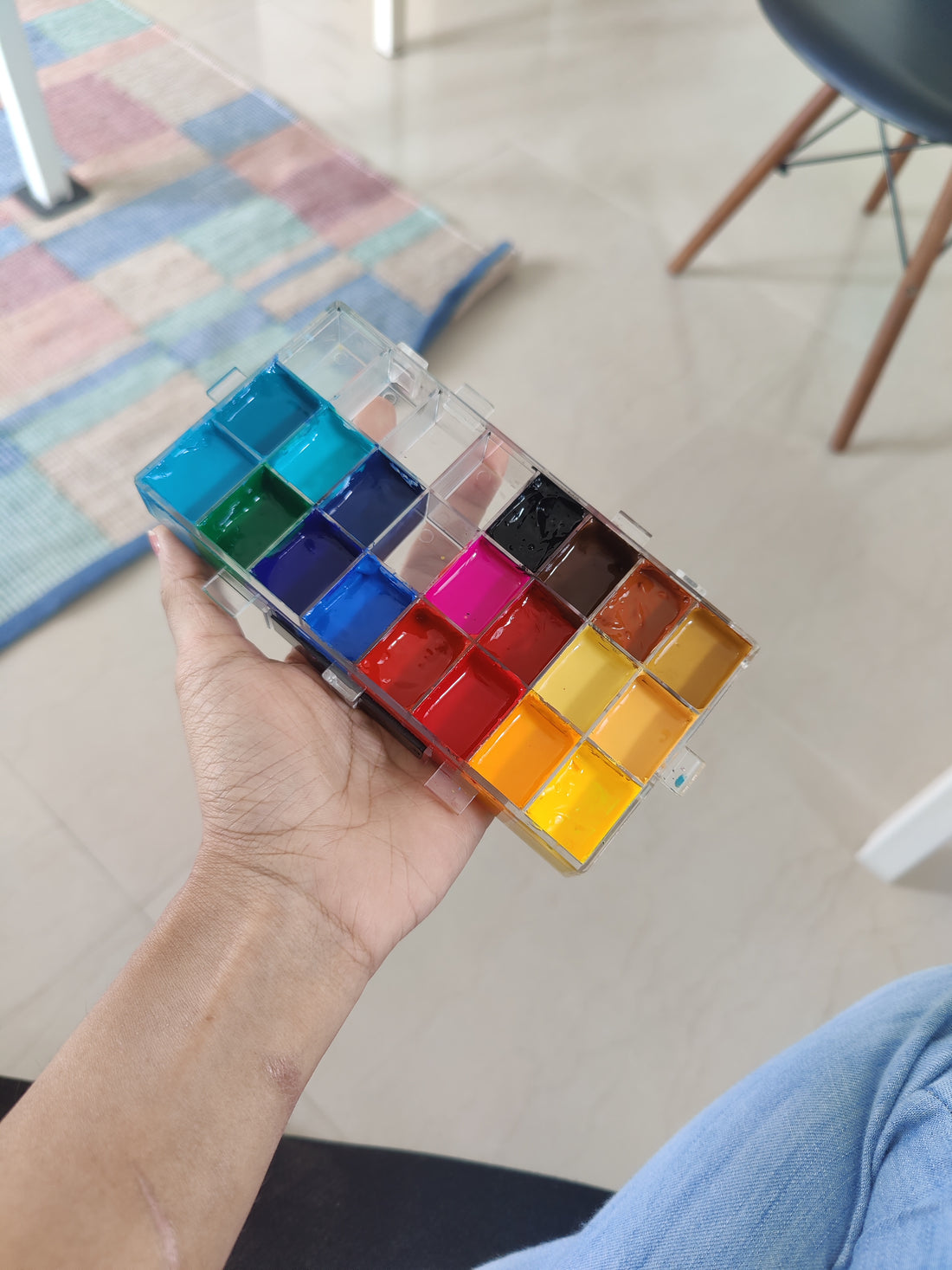Gouache paints are known for their vibrancy and matte finish. It is a water-based medium that consists of pigments mixed with a binder, usually Gum Arabic. Like any water-based paint, it will tend to dry out, harden, or transfer and stick to the walls of your palette as you paint - not a very pretty sight when you want to sit down to paint!
So to maintain the quality and extend the lifespan of your gouache paints, it's important to take some time out now and then to clean and rehydrate your colours.
This will also ensure that your palette is ready to use anytime the inspiration or desire strikes! I mean, the last thing you need when you finally find the mood, inspiration, time, AND headspace to pain is a dirty dry palette, right?!
In this article, we will explore the steps involved in palette maintenance and provide useful tips to keep your gouache paints in optimal condition.
If you are a visual person who gets a kick out of cleaning videos, then you can jump on to see how I clean my gouache palette :
If you’d like a quick gist of my palette-cleaning process, then continue reading!
Let’s quickly jump into what you’ll need, why, and how you can go about cleaning your palette!
What You’ll need:
Remember, the list here is what I use! Feel free to find substitutes for the “tools” that I've used here from around your home!
- Your Air-tight gouache palette
- Paint brushes (pull out your older or less expensive ones for this!)
- Paint tubes for refilling
- Blending medium (I use the Winsor & Newton Blending Medium) to even out the consistencies
- Spray bottle to wet the paint if needed
- Eye dropper for adding the medium
- Toothpicks to scrape out dried paint or mix paints
- Water to wash your brushes and other tools
- And if you’re feeling fancy, palette knife to scrape out dried paint or mix paints!
- Rag cloth, tissues, or earbuds.
What are we going to tackle:
Since it had been a while since I cleaned my palette, I had a few things I had to tackle. This included,
- Dried paint flecks in the empty wells
- Some paint had transferred onto neighbouring wells
- Paint buildup on top and walls of the wells
- Paint transferred onto the lids (My bad, I overfilled them :P)
- Inconsistency in the texture of my paints (because some paints tend to dry sooner than others!)
How I go about cleaning my gouache palette:
1. Cleaning the palette
The first thing I do is remove the lid and carefully remove the silicone lining on the lid. This lining helps keep the paint fresh and soft for longer. I then wash both of them using water and if required an old toothbrush to scrub any dried paint stuck to the lining or the lid. Once done, I leave it out to dry.
Now onto the palette itself. I use a palette knife to scrape off any paint that is dried and stuck to the top of the wells and the walls and corners of the wells. You can also use a toothpick, the back of a spoon, blunt scissors, or any similar relatively blunt sharp object if that makes sense!
2. Cleaning the paints
Once you are done, use the palette knife or the back of a spoon to pick out (aka very lightly scoop out) any paint that has transferred onto another colour. If the paint is too dry or difficult to pick out, spray some water and let it sit for a while before doing this.
Similarly, add water to any empty wells with flecks of dried paint so it can soak while you’re working on the other colours. This will help you clean them out more easily.
Now you can use a wet rag or earbuds to clean out the empty wells and if your obsession is as real as mine then even the walls and tops of the wells with paint in them!
3. Rehydrating and refilling
Finally, the fun part! Use the dropper to add the blending medium 3-4 drops at a time to get your desired paint consistency. You can use a toothpick to mix the paint instead of a brush to reduce any wastage.
Now is a good time to refill any colours that are running too low and add any new colours to your palette. Remember to fill only up to 60% of your well and add a little medium even to the fresh colours. This will help the paint stay fresh for longer.
Once I’m done refilling my palette, I usually go in once again with a wet cloth or earbuds to clean the sides of the wells so it look neat and clean, at least until I paint the next time! ;D
That’s it, now you can place the silicone lining back on the lid and close your palette tightly. Remember to place the silicone perfectly, because this is what keeps your palette airtight. Your palette is now clean and ready to use!
By incorporating regular palette maintenance into your artistic routine, you can enhance your painting experience and extend the lifespan of your gouache paints. Cleaning your palette, removing dried paint flecks, rehydrating colours, and refilling as needed will result in a clean and vibrant palette, ready for your creative inspirations. Remember to personalize the process to fit your routine!
If you’re new to gouache and are looking to learn how to set up your first gouache palette, then here’s a video where I explain everything you need to know about setting up your gouache palette!

